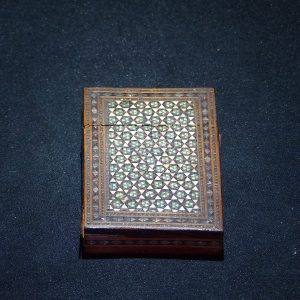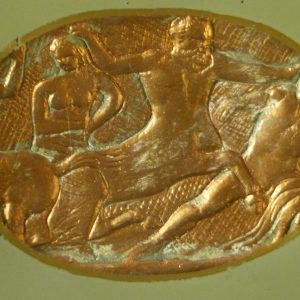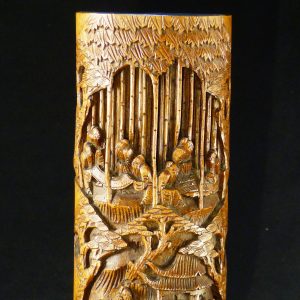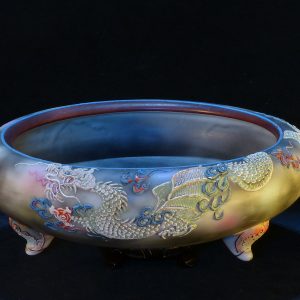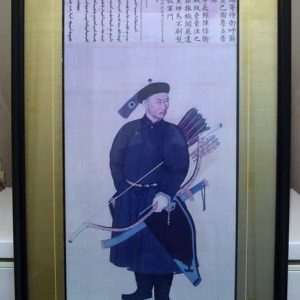Description
清 乾隆 水彩人物畫
參考: 紐約大都會博物館 清 佚名 乾隆頭等侍衛占音保像 軸 Portrait of the Imperial Bodyguard Zhanyinbao
dated 1760
Unidentified Artist

Under the Manchu emperors of the Qing dynasty, portraiture again became an important court-sponsored art. This full-length depiction of an imperial bodyguard of the first rank is from a set of one hundred portraits of loyal officials and valiant warriors commissioned by the Qianlong emperor (r. 1736–95) that originally hung in the Hall of Imperial Brilliance (Ziguang Ge), the pavilion in the Forbidden City where the emperor received tribute offerings and entertained foreign emissaries.
The poem inscribed in both Chinese and Manchu above the painting lauds Zhanyinbao’s valor in combating nomadic rebels in the desert wastes of Central Asia:
Barehanded he rode the giant whale,
Capturing Weinuo in battle.
The bandits’ heads were strung together
The length of his long lance.
With both hands he held open the declaration of war
All the way to Balikun [in Sinjiang Province].
Without [even pausing] to comb his horse’s mane,
He returned and reported to his commander.
Object Details
Artist:Unidentified Artist Chinese, 18th century
Period:Qing dynasty (1644–1911)
Date:dated 1760
Culture:China
Medium:Hanging scroll; ink and color on silk
Dimensions:Painting and inscription: 74 1/4 x 37 7/16 in. (188.6 x 95.1 cm)
Overall with mounting: 130 1/2 x 46 3/8 in. (331.5 x 117.8 cm)
Overall with knobs: 130 1/2 x 50 1/4 in. (331.5 x 127.6 cm)
Classification:Paintings
Credit Line:Purchase, The Dillon Fund Gift, 1986
Accession Number:1986.206
Audio
#7655. Portrait of the Imperial Bodyguard Zhanyinbao
For Audio Guide tours and information, visit metmuseum.org/audioguide.
Supported by Bloomberg Philanthropies
Signatures, Inscriptions, and Markings
Inscription: No artist’s inscription, signature or seal
Colophon
Liu Tongxun 劉統勲 (1698–1773), Liu Lun 劉綸 (1711–1773), Yu Minzhong 于敏中 (1714–1779), 10 columns in standard script, dated 1760:
頭等侍衛呼爾查巴圖魯占音保
赤手長鯨,陣俘衛諾。賊級纍纍,注之一槊。捧檄闢展,達巴裏坤。馬不刷鬛,還報軍門。
乾隆庚辰春臣劉統勲、臣劉綸、臣于敏中奉勑恭賛。
Collector’s seal
Qing emperor Qianlong 清帝乾隆 (r. 17360–1795)
Qianlong yulan zhi bao 乾隆御覽之寳
Provenance
Exhibition History
Zurich. Museum Rietberg. “The Mandate of Heaven: Emperors and Artists in China,” April 2, 1996–July 7, 1996.
Museum für Asiatische Kunst, Staatliche Museen zu Berlin. “The Mandate of Heaven: Emperors and Artists in China,” August 3, 1996–November 10, 1996.
New York. The Metropolitan Museum of Art. “The New Chinese Galleries: An Inaugural Installation,” 1997.
New York. The Metropolitan Museum of Art. “When the Manchus Ruled China: Painting under the Qing Dynasty (1644–1911),” February 2, 2002–August 18, 2002.
New York. The Metropolitan Museum of Art. “The Douglas Dillon Legacy: Chinese Painting for the Metropolitan Museum,” March 12, 2004–August 8, 2004.
New York. The Metropolitan Museum of Art. “The Emperor’s Private Paradise: Treasures from the Forbidden City,” February 1, 2011–May 1, 2011.
Timeline of Art History
Essays
The Qing Dynasty (1644-1911): Painting
The Qing Dynasty (1644-1911): The Courtiers, Officials, and Professional Artists
Timelines
Central and North Asia, 1600-1800 A.D.
China, 1600-1800 A.D.
MetPublications
“Some Notable Sabers of the Qing Dynasty at The Metropolitan Museum of Art”: Metropolitan Museum Journal, v. 36 (2001)
Recent Acquisitions: A Selection, 1986–1987
参考:佳士得拍賣 2083
中國宮廷御製藝術精品
香港|2001年4月29日
拍品580|大清乾隆 皇家一品护卫 THE PROPERTY OF A COLLECTOR
ANONYMOUS (18TH CENTURY)
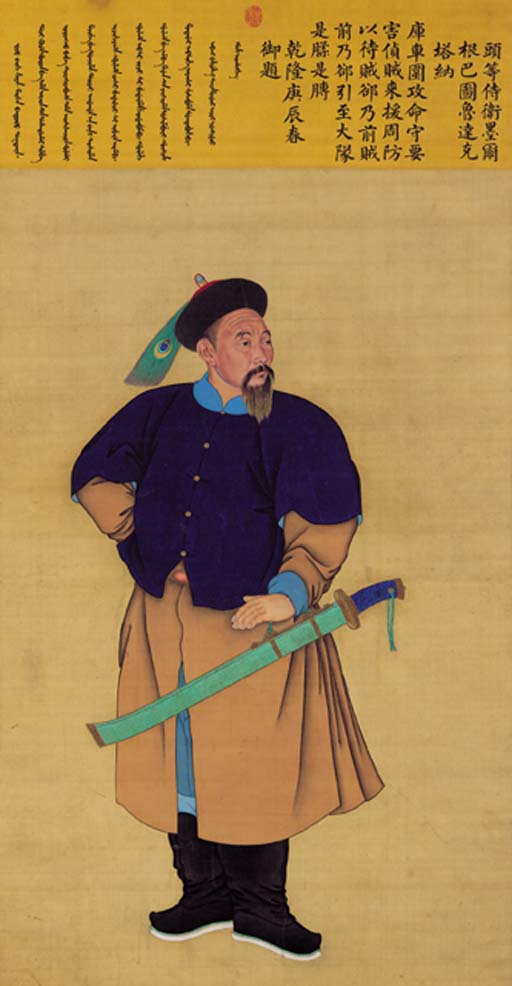
成交總額
HKD 870,000
估價
HKD 800,000 – HKD 1,000,000
ANONYMOUS (18TH CENTURY)
PORTRAIT OF MOER GEN BATULU DAKETANA, IMPERIAL GUARD OF THE FIRST RANK
Hanging scroll, ink and colour on silk
188 x 95.2 cm. (74 x 37 1/2 in.) including inscription above the painting
Entitled and inscribed by Qianlong Emperor (reigned 1736-1795) above the painting, with one seal of the Emperor: Qian Long Yu Lan Zhi Bao
Dated spring, gengchen year of the Qianlong era (1760)
拍品專文
(US$103,200-129,000)
NOTES:
This scroll is part of a group of paintings commemorating the military success of Qing forces in the northwestern frontier of China between 1755 to 1759. As a result of these military campaigns, the Yili Valley and Eastern Turkestan came under Chinese contral and was renamed Xinjing.
According to the research of Nie Chongzhen of the Palace Museum, Beijing, a total of two hundred and eighty meritorious servitors’ portraits were painted during Emperor Qianlong’s reign. These paintings can be divided into three groups: one hundred of those who put down the Heibu rebellion of western China (the first fifty were inscribed by Qianlong); one hundred of thoses who quelled the Daxiao Jingchuan rebellion (the first fifty also inscribed by Qianlong); fifty of those who ended the Taiwan rebellion, and the remaining thirty of those who stopped the Guo’er rebellion.
Of all the portraits painted, only twenty can bow be accounted for, mostly in public and private institutions. This is one of the few only remaining meritorious servitor portraits left in private hands. Of the other know hanging scrolls:
two are in the Royal Ontario Museum, Canada;
three are in the Museum fur Ostasiatische Kunst, Berlin, Germany;
two are in the Museum fur Volkerkunst, Hamburg, Germany;
one is in the Museum fur Ostasiatische Kunst, Cologne, Germany;
one is in the Metropolitan Museum, New York, U.S.A.;
one is in the Museum Zamek Zbeastarsky, Russia;
two are in the Museum of History, Tianjin, China;
three are in a private collection in the U.S.A.;
two are in private collections in Hong Kong;
two whose whereabouts are still not know;
and the present lot.
The inscription above the painting honours the soldier for his role in military action in Kucha
編製圖錄及詳情
拍品前備註
THE PROPERTY OF A COLLECTOR
参考:佳士得拍賣 2622
重要中國瓷器及工藝精品
Hong Kong|2008年12月3日
拍品2502|清乾隆 御製平定兩金川紫光閣五十功臣像贊十六
原參贊大臣西安提督哈國興
設色絹本 立軸
A MAGNIFICENT LARGE IMPERIAL COURT PORTRAIT OF HA GUOXING, FORMER COUNSELLOR-MINISTER AND COMMANDER-IN-CHIEF OF XI’AN
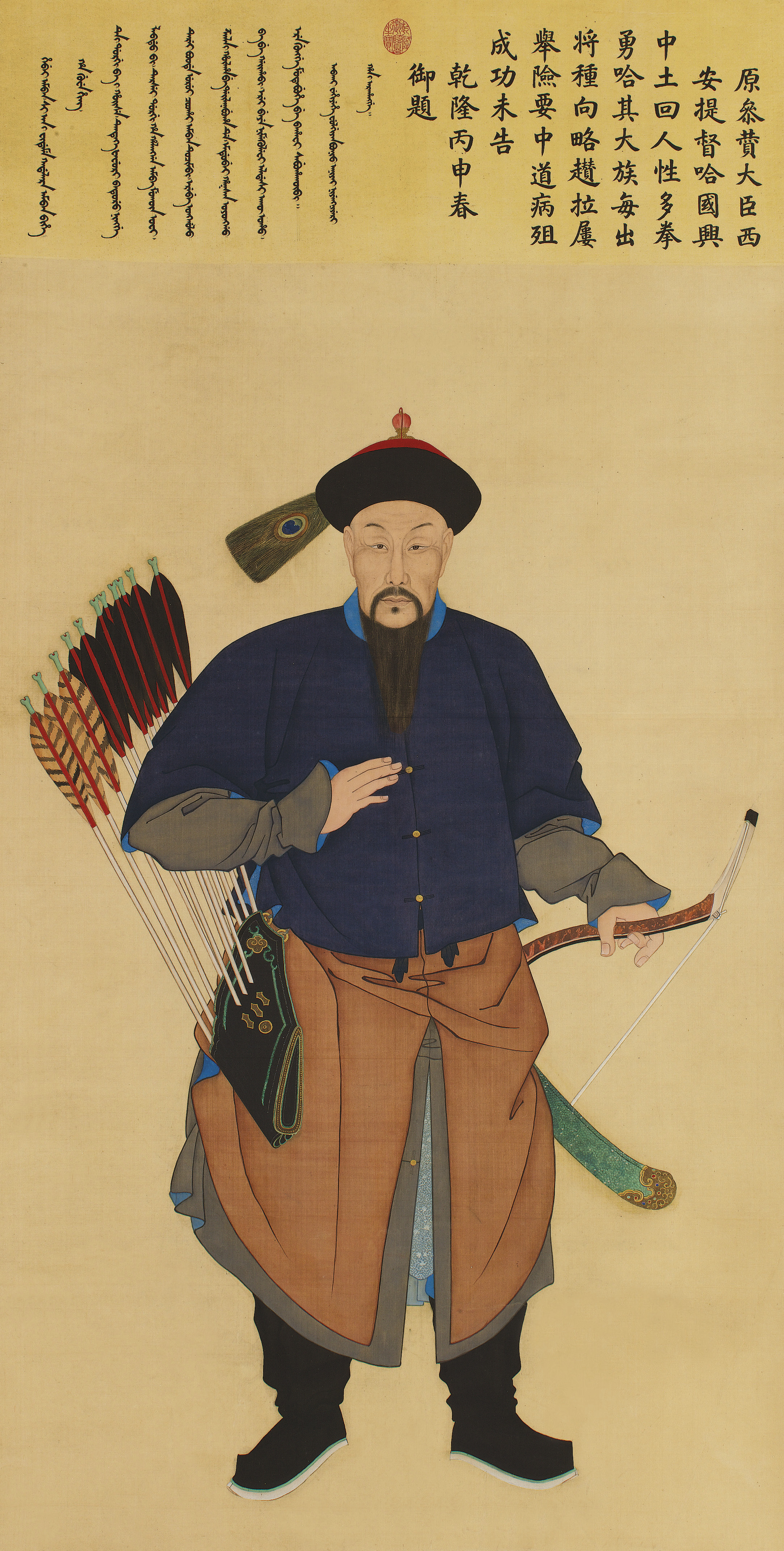
原參贊大臣西安提督哈國興
設色絹本 立軸
成交總額
HKD 4,820,000
估價
HKD 4,500,000 – HKD 6,500,000
來源
Baron Klaus-Detlof von Oertzen
拍品專文
The present portrait belongs to a group of two hundred and eighty paintings commissioned by Emperor Qianlong in honouring his generals and military commanders whose distinguished military skills contributed to the success of frontier campaigns that took place during the Qianlong reign. According to research by Nie Chongzheng of the Palace Museum, a decree noted that portraits of fifty meritorious bannermen were to be painted by Jin Tingbiao (d. 1767), and Ai Qimeng (Ignaz Sichelbart)(1708-1780) was ordered to render the faces. Mr Nie’s research had divided these portraits into three groups. The first set is comprised of one hundred portraits of those who helped to quell border problems in Xiyu (part of Central Asia region which was subsequently re-named Xinjiang). Fifty of these were personally inscribed with praises written by the Emperor and the remainder were written by his ministers. The second group of a hundred portraits, to which the present painting belongs, were of those who suppressed the Daxiao Jinchuan, the two Jinchuan regions (located Northwest of Sichuan). The third group is composed of fifty portraits of military officials who ended the Taiwan uprising and the remaining thirty were of those who stopped the Guo’er rebellion.
This group of meritorious servitors’ portraits was originally placed in the Ziguang Pavilion, located on the west bank of Zhonghai of the West Garden in Beijing. The Ziguang Pavilion was originally built during the reign of the Ming dynasty Emperor Zhengde (1506-1521) and by the Qing dynasty, Emperor Kangxi (1622-1722) had set a precedence by reviewing troops on the grounds of the pavilion. It is not certain when these portraits were removed from the Ziguang Pavilion but Mr Nie Chongzheng is of the opinion that they were taken around the 26th year of the Guangxu reign (1900) when Beijing was occupied by Allied Forces of the Eight Nations. It is highly probable that the entire collection was lost during this period. It is interesting to note that no examples of this type of paintings are in the collections of the Beijing Palace Museum or the National Palace Museum, Taipei; and only two are in the Tianjin Museum collection. These are portraits of ‘The Officer Ayuxi’ who pacified Xiyu; and ‘General Shujing’an’, who was the Deputy Commander of Chengdu and led troops to pacify Daxiao Jinchuan.
Examples found in institutions include two in the Royal Ontario Museum, Toronto; one of which is a portrait of the Military Governor Namjar, an Imperial Bodyguard of the 3rd rank, illustrated in Homage to Heaven Homage to Earth, Toronto, 1992, no. 138. There are three paintings in the Museum für Asiatische Kunst, Berlin; and one in the Museum für Ostasiatische Kunst, Cologne. A painting in the Metropolitan Museum collection, New York, depicting the First Rank Bodyguard, Huerchaba, is illustrated in La Cite Interdite, Paris, 1996, p. 26, fig. 22. In addition, a total of seven servitor paintings that have been sold at auction, as listed below:
1. Portrait of Huer Chaba, Imperial Bodyguard of the 1st rank, sold at Sotheby’s New York, 3 June 1986, lot 90.
2. Portrait of Fu Heng, Grand Secretary of the first rank (the younger brother of Qianlong’s consort, Empress Xiao Xian), sold at Sotheby’s New York, 23-25 April 1987, lot 56.
3. Portrait of Keshiki Batu Luwuke Shi’er, Imperial Bodyguard of the 3rd rank, sold at Christie’s New York, 27 March 1996, lot 101.
4. Portrait of Wufu, Brigadier General of Gansu region, sold at Sotheby’s New York, 2 December 1992, lot 68, and again at Christie’s Hong Kong, 26 April 1999, lot 532.
5. Portrait of Moer Gen Batulu Daketana, Imperial Bodyguard of the 1st rank, sold at Christie’s Hong Kong, 27 April 1997, lot 98, and sold again at Christie’s Hong Kong, 29 April 2001, lot 580.
6. Portrait of Tanibu, Imperial Bodyguard of the 2nd rank, sold at Sotheby’s New York, 1 June 1993, lot 53, and sold again at Sotheby’s Hong Kong, 9 October 2007, lot 1315.
7. Portrait of Yisamu, Imperial Bodyguard of the 1st rank, sold at Sotheby’s Hong Kong, 9 October 2007, lot 1314.
There is an additional reduced portrait showing the only head and upper body of a bannerman who has been identified as Dalhan, Imperial bodyguard of the 2nd rank, that was sold at Sotheby’s Hong Kong, 9 October 2007, lot 1316.
The present military hero, Haguoxing, took part in the campaigns of the two Jinchuan Regions. The battles took place between 1771-1776, and by the time this painting was commissioned in 1776, Haguoxing had already passed away. The Jinchuan battle scenes are depicted in an album of 16 leaves, illustrated in Paintings by the Court Artists of the Qing Court, The Complete Collection of Treasures of the Palace Museum, Hong Kong, 1996, pp. 259-267, no. 69.
編製圖錄及詳情
拍賣現場通告
Please note that the estimate of this lot should read:
HK$4,500,000-6,500,000
拍品前備註
BARONESS IRENE VON OERTZEN
The late Baroness Irene von Oertzen (1908-2007) and her husband Baron Klaus-Detlof von Oertzen (1894 – 1991), were passionate collectors of Chinese art, who together amassed a remarkable collection, particularly in regards to Chinese jade carvings. The Baroness not only could speak and write fluent Chinese, she also had a profound understanding of Chinese culture, having lived and worked in China for seven years. The Baron is descended from one of the oldest families of North Germany and was a world-renowned industrialist involved in the motor industry for most of his long life. The couple settled in South Africa after the Second World War, and he is sometimes referred to as the “Father of Volkswagen of South Africa”.
In 1932 Baron von Oertzen, who had been in charge of sales at the motor manufacturer Wanderer, became sales director and chairman of the board of directors of Auto Union – the amalgamation of Wanderer and three other German manufacturers, namely Audi, DKW and Horch, under the pressures of the depressed German economy. The new company’s four-ringed emblem, which von Oertzen suggested, can still be seen in the modern Audi logo.
To bring fame to the new company, von Oertzen, in collaboration with Dr. Ferdinand Porsche and one of Germany’s most successful racing drivers, Hans Stuck, began work on a government-sponsored racing programme, in direct competition with rival Mercedes-Benz. By 1934 the racing cars produced by Auto Union broke five world speed records and made Auto Union a world renowned car manufacturer. Despite the success the von Oertzens were not comfortable with the prevailing political ideology at the time, and grew uneasy in pre-war Germany. In November 1935 the Baron and Baroness went to Paris to open the Motor Show for Auto Union and, without returning to Germany, departed for South Africa. From 1936 he initiated the export of the DKW saloon car to South Africa and Australia and in 1937 he arranged for the Auto Union Grand Prix racing cars to be brought out to South Africa for promotional purposes. The car competed in races both in Cape Town and East London.
The Baron and Baroness travelled in 1938 via India to Australia, where they stayed for two years, setting up a factory to manufacture the DKW saloon. Before the outbreak of war the car was selling at the rate of 2000 a year in Australia and New Zealand. As the war clouds gathered business was declining, and the couple arrived in Batavia (modern day Jakarta) of the Dutch East Indies. In May 1940 Hitler invaded Holland, and the Baron and Baroness were interned separately in prison camps by the Dutch authorities. He was later transferred to India as the Japanese approached Singapore, while she was transferred to China. The Baroness managed to get a job working for the Canadian Consulate General in China, and during her years in China she began her studies in Chinese culture and language. It was during this period that her passion for Chinese art developed. The Baroness had a special fondness for jade carvings, and the von Oertzen collection includes a distinguished group of jade pieces from as ancient as the Neolithic times to the early 20th century which are to be offered at Christie’s London on 4th November 2008.
The Baroness, through her contacts in the consulate, managed to transfer her husband to China, and was finally reunited with him after six years of separation. Just as the Baron estabished himself in Shanghai as a second-hand car dealer, the civil war broke out between the Communists and the Nationalists and the couple found themselves once again embroiled in war. They eventually had to leave and returned to South Africa in 1948. In 1951 Volkswagen in Germany appointed Baron von Oertzen as their representative in South Africa. He was instrumental in the early stages of negotiations to bring Volkswagen to South Africa, and was present at the historic signing in 1951 of the agreement between SAMAD and Volkswagenwerk to assemble Volkswagens in Uitenhage. When Volkswagenwerk took over a controlling interest in SAMAD in 1956, he became the chairman of the company, which eventually changed its name to Volkswagen of South Afirca.
The Baroness in her later years divided her time between Johannesburg and Switzerland. She was a guest of honour at the opening of the AutoPavilion in 2004, where a Jagdwagen Kombi, the second Kombi ever to arrive in South Africa, and which used to belong to Baron von Oertzen, was displayed.
A PORTRAIT OF HA GUOXING, FORMER COUNSELLOR-MINISTER AND COMMANDER-IN-CHIEF OF XI’AN
NIE CHONGZHENG – RESEARCH FELLOW, PALACE MUSEUM, BEIJING
In recent years, several portraits belonging to the group collectively known as the meritorious servitor paintings of Ziguang Ge (Hall of Purple Glory) have appeared at auction, and Christie’s will present another this autumn, namely the Portrait of Ha Guoxing, Former Counsellor-Minister and Commander-in-Chief of Xi’an.
This is a hanging scroll of ink and colour on silk, measuring 185.5 X 94.5 cm. Inscribed on the “poetry hall”, i.e. a piece of silk mounted above the painting, is a eulogy, “The Hui [ethnic minority] living on the Central Plains are renowned for their gallantry, and the Ha clan is a major Hui group displaying considerable military prowess. When conquering Zanla (the Lesser Jinchuan), [Ha Guoxing] played a key part in seizing several strategic points. Unfortunately, Ha died of illness before the military campaign concluded successfully. Dated spring, Bingshen year of the Qianlong era.” The same inscription also appears in Manchu script, and affixed between the Chinese and Manchu inscriptions is an oval seal carved in relief with Qianlong yulan zhi bao (Imperial Treasure of Qianlong). The legend on the outer scroll bears an inscription that reads, “The sixteenth of the fifty imperial portraits of the meritorious servitors involved in the conquest of the Lesser and Greater Jinchuan, depicting Ha Guoxing, late counsellor-minister and commander-in-chief of Xi’an.” The painting itself is inscribed with “Qianlong bingshen chun yuti (Inscribed in spring, Bingshen year by Emperor Qianlong”, with Bingshen referring to the forty-first year of the Qianlong era (1776). The Ziguang Ge list of meritorious servitors includes a hundred military officials who helped conquer the Greater and Lesser Jinchuan, and they can be subdivided into two groups of fifty. Bearing an inscription by the Qianlong Emperor and ranked the sixteenth on the list, the current portrait clearly belongs to the first group. The portrait features a standing military official wearing a single-eyed peacock feather streamer, with a broad sword, a bow bag and an arrow pouch hanging from his waist. The character, Yuan, is mentioned in the inscriptions on the “poetry hall” and the inscription on the outer side of the scroll, suggest that this particular meritorious servitor had already died by the time of the portrait. Emperor Qianlong’s eulogy also mentions that “Ha died of illness before the military campaign concluded successfully.” So it seems that the portrait was done without Ha’s sitting for it, and the representation was based solely on others’ recollections of Ha’s appearance.
Both Yucao zazhi (vol. 1) by Zhao Shenzhen and Qing Shigao (Draft History of Qing) note that Ha Guoxing was ranked sixteenth on the list, which is in perfect accord with the inscription of the current painting. While Yucao zazhi only mentions the name “Ha Guoxing”, Qing Shigao describes Ha as a “Counsellor-Minister and Commander-in-Chief”, but neither mentions that Ha had passed away by the time of the painting.
While the authorship of the servitor paintings celebrating the conquest of the Greater and Lesser Jinchuan remains unclear as all portraits of this group are unsigned, the Records of the Imperial Household do offer some clues. According to an entry dated to the forty-fourth year of the Qianlong era, “On the fifteenth day of the twelfth month, counsellors Side and Wude came and ordered Eunuch Eleli to tell Shu Wen: Instruct artist Lu Can to return to the South upon completing the servitor paintings. On the seventeenth day, Shu Wen, who is in charge of the affairs of the Board of Works at the Yangxin dian (Hall of Mental Cultivation), told painter Lu Can to return to the South upon finishing the servitor paintings. But with the move of the imperial family to the Qixiang Gong (Palace of Blessings) scheduled for the first month of next year, all painters will be required to move to Yuanming Yuan. Your humble servant will therefore let Lu Can stay at the Imperial workshops and send someone over to look after him. Lu and his family staying in Beijing will be told to return to the South within three days after completing the servitor paintings. Eunuch Eleli has been told to announce the arrangements. Instruction received and understood. End of the Imperial command.”
The servitor paintings mentioned in the Imperial records clearly refer to those marking the conquest of the Greater and Lesser Jinchuan, and Lu Can seems to have been one of the painters involved in the project. On Lu Can as a painter, Qian Yong notes in Luyuan huaxue, “Lu Can, courtesy name (zi) Xingsan and native of Changzhou, was skilled at figure and flower paintings and an established portraiture artist in his time. He was summoned by an Imperial order to do a portrait for the Emperor in the Gengzi year of the Qianlong era, which corresponds to the forty-fifth year of the Qianlong era (1780). Yiu Boxuan, one of Lu’s pupils, was also one of the finest portrait artists in central Wu.” In Guochao huazhi (vol. 13) published in the Qing dynasty, Feng Jinbo quoted Huayou lu as saying, “Lu Can, courtesy name Xingsan and native of Loudong, was one of the most accomplished pupils of Zhang Binru from Hudu. By an Imperial command, he was commissioned to do a portrait of the Emperor during the forty-fifth year of the Qianlong era and was generously rewarded as a result. He was summoned again to serve in court the following year, this time to do a portrait of the Eleventh Panchen Erdeni (Gyantsen Norpo) from the Western Regions visiting the Qing court. Lu’s flower paintings could rival those by Nantian [the sobriquet of Yun Shouping], but were unfortunately marred by excessive verisimilitude. Moxiang[Feng Jinbo]’s note: “Xingsan was also skilful at depicting bamboo and was on familiar terms with Zhang Binru, even though Xingsan never formally acknowledged Zhang as his mentor.” Lu Can is also mentioned in Liumei huajia luezhi by the Qing scholar Wang Li, “Lu Can, courtesy name Xingsan, was skilled at painting bamboo and flowers and was a disciple of Yun Zhengshu [Yun Shouping] from Piling [now known as Changzhou, Jiangsu province].” From these quotes, we can safely assume that Lu was a portrait artist of considerable repute, whose paintings of bamboo, rocks and flowers were also quite accomplished.
Judging by the inscriptions on the current portrait and the records quoted above, it seems clear that Qianlong composed and inscribed the eulogy in the forty-first year of his reign (1776), while the portrait itself was painted by artists such as Lu Can during the forty-fourth and forty-fifth years of the Qianlong era (1779-80).
(Translated from the Chinese text)
PROPERTY OF THE LATE BARONESS IRENE VON OERTZEN
SOLD BY THE ORDER OF THE EXECUTORS
参考:蘇富比 SALE SERIES
Hong Kong Spring Auctions
Asia Week
重要中國瓷器及工藝品
2012年9月11日 – 2012年9月12日 | 上午 10:00 EDT
紐約
246 歐洲私人收藏
清乾隆 艾啟蒙及金庭標 《平定西域紫光閣五十功臣像贊》 參贊大臣喀爾喀扎蕯克多羅郡王車木楚克扎布 設色絹本 立軸 「乾隆御覽之寶」印
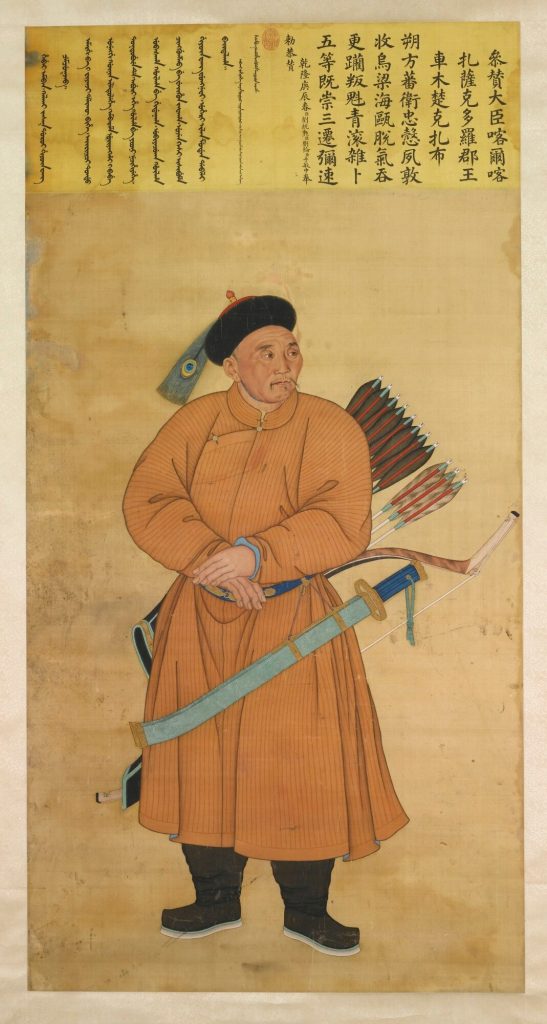
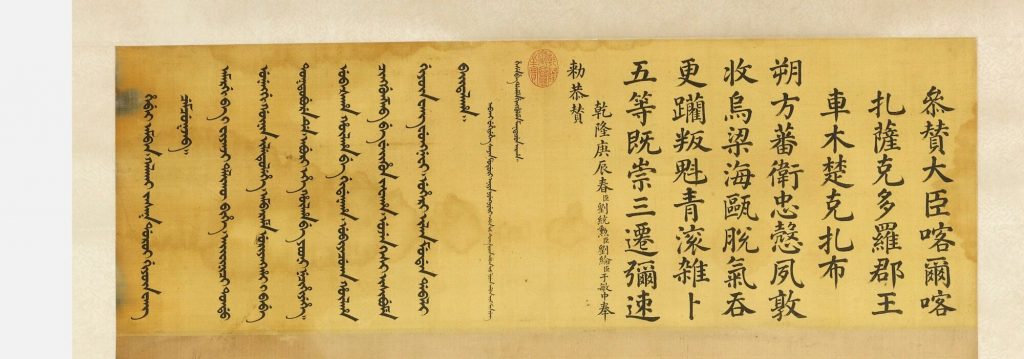
估價 300,000 — 500,000 美元
拍品已售 692,500 美元 成交價 (含買家佣金)
拍品詳情
清乾隆 艾啟蒙及金庭標 《平定西域紫光閣五十功臣像贊》 參贊大臣喀爾喀扎蕯克多羅郡王車木楚克扎布 設色絹本 立軸 「乾隆御覽之寶」印
詩堂字:
「參贊大臣喀爾喀扎蕯克多羅郡王車木楚克扎布
朔方蕃衛 忠愨夙敦
牧鳥梁海 甌脫氣吞
更躪叛魁 青滾雜卜
五等既崇 三遷彌速
乾隆庚辰春 臣劉統勳 臣劉綸 臣于敏中 奉敕恭贊」
高 60 3/8 英寸,151.5 公分; 寬 37 3/8 英寸,95 公分
狀況報告
來源
軍士長溫詩於1901至1905年間於北京購之。
展覽
Die Bilder für die Halle des Purpurglanzes: Chinesische Offiziersporträts und Schlachtenkupfer der Ära Qianlong (1736-1795),東亞藝術博物館,柏林,2003,品號4。
出版
鮑登,《1756-1757蒙古叛亂》登於《亞洲歷史期刊》2,1968,第1-31頁。
華瑞凡,《乾隆十大武功功臣像之新見》載於《中亞與歐洲之歷史和語言交流》,匈牙利賽格德,1997,第401-423頁。
聶崇正,《談紫光閣功臣像》,北京,2008,第138-169頁,重點第151-152頁。
相關資料
本拍品為大清帝國北方邊疆指揮官喀爾喀扎(1776年卒)之肖像。畫上方有漢滿雙文贊文,頌揚喀爾喀扎為人正直忠義,有降服烏梁海地區反清亂賊、活禽其首腦青滾雜卜之卓越戰功,因而備受朝廷器重,更獲賜郡王封銜:
參贊大臣喀爾喀扎薩克多羅郡王車木楚克扎布。
朔方藩衛忠慤夙敦,牧烏梁海甌脫氣吞,更躝叛魁青滾雜卜五等,既崇三遷彌速。
乾隆庚辰春,臣劉統勳、臣劉綸、臣于敏中奉勒恭贊。
為鉗制準噶爾國,鞏固大清版圖,乾隆皇帝於1755-59年間下令出兵東突厥斯坦,而旗人喀爾喀扎便於當中立下重要戰功。經此戰大捷,清朝成功從準噶爾手上贏取對西藏達賴喇嘛之控制權,並平定伊斯蘭化的南疆突厥語地區,確立大清帝國於中亞廣大地區之勢力。
本拍品為1760年繪製第二系列旗人功臣像中之第六幅。此系列之贊文皆由劉統勳、劉綸、于敏中三位大臣親筆譔寫。圖中可見喀爾喀扎正值英年,身穿淺褐色長袍,頭戴黑暖帽。帽上插單眼花翎,為武官獲戰功後受御賜之物。喀爾喀扎的側臉站姿常見於同類傳統中國肖像畫中,而身軀之粗線勾勒、鮮艶著色,皆屬十八世紀宮廷繪畫之典型風格。喀爾喀扎之面容輪廓描繪寫實細膩,具立體感,雙眼更以白色顔料點出亮點,反映了十八世紀耶穌會傳教士傳入清宮畫院之西洋畫風。
值得一提的是,專業人士清理本拍品時,於肖像面部底下之絹本發現喀爾喀扎名稱的標記。有學者認為清代宮廷肖像畫之製作中,先由宮廷畫師繪製身軀,後由傳教士以西洋技法補畫頭臉。此標記該是當時畫師為避免混淆肖像身份而作,為上述觀點提供了有力證據。
關於旗人肖像畫,詳見聶崇正「新發現紫光閣功臣伊薩穆像」一文(載於《末日帝國的北京》,蘇富比,倫敦,2007年,頁112-3)。下列數幅同類旗人功臣像亦曾於本場售出。扎爾善像與本拍品屬同一系列,2009年5月13日於倫敦蘇富比售出,拍品編號136。伊薩穆像傳為艾啓蒙、金廷標合作,2007年10月9日於香港蘇富比售出,拍品編號1314。另兩幅塔尼布像、達爾漢像亦於該拍賣會售出,拍品編號分別為1315、1316。
呼爾查巴像,1986年6月3日於紐約售出,拍品編號90。軍機大臣傅恆像,1987年4月23至25日於紐約售出,拍品編號56。1796年乾隆下令金廷標繪製五十旗人功臣像長卷,其中十幅2005年3月31日至4月1日於紐約售出,拍品編號280。柏林民族學博物館藏有一套旗人半身油畫像,刊載於赫伯特·布特茲等編著《紫光閣繪畫》(柏林,2004年,圖版12至17)。
上述旗人肖像畫原皆藏於京城中南海西苑紫光閣,為紀念大清功臣而作。

![[临渊阁]天地一家春](https://www.antiquekeeper.ca/wp-content/uploads/2023/03/antiquekeeper_banner_image_2-4.jpg)

